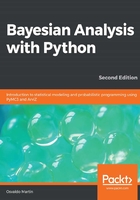
Highest-posterior density
A commonly-used device to summarize the spread of a posterior distribution is to use a Highest-Posterior Density (HPD) interval. An HPD is the shortest interval containing a given portion of the probability density. One of the most commonly-used is the 95% HPD, often accompanied by the 50% HPD. If we say that the 95% HPD for some analysis is [2-5], we mean that according to our data and model, we think the parameter in question is between 2 and 5 with a probability of 0.95.
ArviZ is a Python package for exploratory data analysis for Bayesian models. ArviZ has many functions to help us summarize the posterior, for example, az.plot_posterior can be used to generate a plot with the mean and HPD of a distribution. In the following example, instead of a posterior from a real analysis, we are generating a random sample from a beta distribution:
np.random.seed(1)
az.plot_posterior({'θ':stats.beta.rvs(5, 11, size=1000)})

Note that in Figure 1.7, the reported HPD is 94%. This is a friendly remainder of the arbitrary nature of the 95% value. Every time ArviZ computes and reports a HPD, it will use, by default, a value of 0.94 (corresponding to 94%). You can change this by passing a different value to the credible_interval argument.